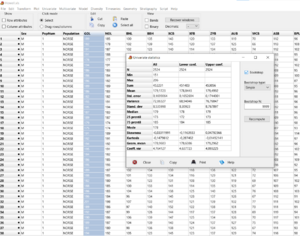Software:Paleontological Statistics
PAST logo | |
 PAST 4.13 running on Windows 10 | |
| Developer(s) | Øyvind Hammer, David A.T. Harper, Paul D. Ryan |
|---|---|
| Initial release | 2001 |
| Stable release | 4.13
/ May 2023 |
| Size | ~30 MB |
| Type | Statistical analysis Numerical analysis |
| License | Freeware |
| Website | www |
PAST (PAleontological STatistics) is a free software package for statistical data analysis with a focus on palaeontological data.
Development
PAST's predecessor was PALSTAT, developed by palaeontologists David Harper (University of Copenhagen) and Paul Ryan (National University of Ireland), first for BBC Microcomputer and later for MS-DOS.[1]
The development of PAST started in 1999, the development team consisted of Harper, Ryan as well as Øyvind Hammer (University of Oslo),[2] who is still the maintainer today.[3]
Functions and Operation
PAST includes functions for data management, data visualisation through graphics, univariate and multivariate analysis procedures as well as linear and non-linear modelling. There are also functions for diversity calculation, time series analysis, geostatistical and stratigraphic analysis.[3]
The operation is basically mouse-controlled. In addition, control via syntax scripts is provided, using a Pascal-like script language.[3]
Usage
PAST was used in a number of paleontological and related studies.[4][5][6][7][8]
The software was recommended because it is "... designed specifically for paleontologists"[9] and "... incorporates a vast majority of analytical methods suitable for paleontological and current ecological work"[10].
Further reading
- Hammer, Øyvind; Harper, David A.T. (2006), Paleontological Data Analysis, Malden/Oxford/Carlton: Blackwell, ISBN 978-0-470-75071-1
- Hammer, Øyvind; Harper, David A.T.; Ryan, Paul D. (2001), "PAST: Paleontological Statistics Software Package for Education and Data Analysis.", Palaeontologia Electronica 4 (1), https://palaeo-electronica.org/2001_1/past/past.pdf
- Hammer, Øyvind (2023), PAST - PAleontological STatistics, Version 4.13, Reference manual., https://www.nhm.uio.no/english/research/resources/past/downloads/past4manual.pdf, retrieved 2023-05-10
References
- ↑ Hammer, Øyvind; Harper, David A.T. (2006), Paleontological Data Analysis, Malden/Oxford/Carlton: Blackwell, ISBN 978-0-470-75071-1
- ↑ Elewa, Ashraf M. T. (2011), Elewa, Ashraf M.T., ed., "Computational Paleontology" (in en), Computational Paleontology (Berlin, Heidelberg: Springer): pp. 1–5, doi:10.1007/978-3-642-16271-8_1, ISBN 978-3-642-16271-8, https://doi.org/10.1007/978-3-642-16271-8_1, retrieved 2023-05-24
- ↑ 3.0 3.1 3.2 Hammer, Øyvind (2023), PAST - PAleontological STatistics, Version 4.13, Reference manual., https://www.nhm.uio.no/english/research/resources/past/downloads/past4manual.pdf, retrieved 2023-05-10
- ↑ Bruner, Emiliano; Ogihara, Naomichi (2018-01-04). "Surfin’ endocasts: The good and the bad on brain form" (in English). Palaeontologia Electronica 21 (1): 1–10. doi:10.26879/805. ISSN 1094-8074. https://palaeo-electronica.org/content/2018/2101-surface-and-form-analysis.
- ↑ Butler, Dava K.; Esker, Donald A.; Juntunen, Kristopher L.; Lawver, Daniel R. (2020-04-16). "An analysis of fossil identification guides to improve data reporting in citizen science programs" (in English). Palaeontologia Electronica 23 (1): 1–21. doi:10.26879/901. ISSN 1094-8074. https://palaeo-electronica.org/content/2020/3010-analysis-of-fossil-id-guides.
- ↑ Knauss, Mathew J.; Yacobucci, Margaret M. (2014-03-17). "GIS-based morphometrics" (in English). Palaeontologia Electronica 17 (1): 1–27. doi:10.26879/418. ISSN 1094-8074. https://palaeo-electronica.org/content/2014/721-gis-based-morphometrics.
- ↑ Cascales-Miñana, Borja; Diez, José Bienvenido (2012-02-14). "The effect of singletons and interval length on interpreting diversity trends from the palaeobotanical record" (in English). Palaeontologia Electronica 15 (1): 1–20. doi:10.26879/266. ISSN 1094-8074. https://palaeo-electronica.org/content/2012-issue-1-articles/123-palaeofloristic-patterns.
- ↑ Papaioannou, Vasiliki A.; Kranioti, Elena F.; Joveneaux, Perrine; Nathena, Despoina; Michalodimitrakis, Manolis (2012). "Sexual dimorphism of the scapula and the clavicle in a contemporary Greek population: Applications in forensic identification" (in en). Forensic Science International 217 (1-3): 231.e1–231.e7. doi:10.1016/j.forsciint.2011.11.010.
- ↑ Brusatte, Stephen L. (2011), Elewa, Ashraf M.T., ed., "Calculating the Tempo of Morphological Evolution: Rates of Discrete Character Change in a Phylogenetic Context" (in en), Computational Paleontology (Berlin, Heidelberg: Springer): pp. 53–74, doi:10.1007/978-3-642-16271-8_4, ISBN 978-3-642-16271-8, https://doi.org/10.1007/978-3-642-16271-8_4, retrieved 2023-05-24
- ↑ Petrakis, Panos V. (2011), Elewa, Ashraf M.T., ed., "The Problem of Instar Numbers in Arthropods" (in en), Computational Paleontology (Berlin, Heidelberg: Springer): pp. 179–219, doi:10.1007/978-3-642-16271-8_10, ISBN 978-3-642-16271-8, https://doi.org/10.1007/978-3-642-16271-8_10, retrieved 2023-05-24
 |

